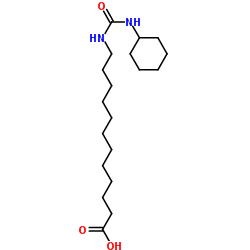CUDA
Modify Date: 2024-01-11 18:41:41

CUDA structure
|
Common Name | CUDA | ||
|---|---|---|---|---|
| CAS Number | 479413-68-8 | Molecular Weight | 340.501 | |
| Density | 1.0±0.1 g/cm3 | Boiling Point | 549.4±19.0 °C at 760 mmHg | |
| Molecular Formula | C19H36N2O3 | Melting Point | N/A | |
| MSDS | N/A | Flash Point | 286.1±21.5 °C | |
Use of CUDACUDA is a potent inhibitor of soluble epoxide hydrolase (sEH), with IC50s of 11.1 nM and 112 nM for mouse sEH and human sEH, respectively[1]. CUDA selectively increases peroxisome proliferator-activated receptor (PPAR) alpha activity. CUDA may be valuable for the research of cardiovascular disease[2]. |
| Name | 12-(cyclohexylcarbamoylamino)dodecanoic acid |
|---|---|
| Synonym | More Synonyms |
| Description | CUDA is a potent inhibitor of soluble epoxide hydrolase (sEH), with IC50s of 11.1 nM and 112 nM for mouse sEH and human sEH, respectively[1]. CUDA selectively increases peroxisome proliferator-activated receptor (PPAR) alpha activity. CUDA may be valuable for the research of cardiovascular disease[2]. |
|---|---|
| Related Catalog | |
| Target |
PPARα mouse sEH:11.1 nM (IC50) human sEH:112 nM (IC50) |
| In Vitro | CUDA (10 μM; 18 hours) produces 6- and 3-fold increases of PPARalpha in COS-7 cells[2]. CUDA does not alter PPARalpha protein expression, and it competitively inhibits the binding of Wy-14643 (pirinixic acid) to the ligand binding domain of PPARalpha, suggesting that it functions as a PPARalpha ligand[2]. Western Blot Analysis[2] Cell Line: COS-7 cells Concentration: 10 μM Incubation Time: 18 hours Result: Activated PPARα by binding to the ligand binding domain of PPARα. |
| References |
| Density | 1.0±0.1 g/cm3 |
|---|---|
| Boiling Point | 549.4±19.0 °C at 760 mmHg |
| Molecular Formula | C19H36N2O3 |
| Molecular Weight | 340.501 |
| Flash Point | 286.1±21.5 °C |
| Exact Mass | 340.272583 |
| PSA | 78.43000 |
| LogP | 4.79 |
| Vapour Pressure | 0.0±3.2 mmHg at 25°C |
| Index of Refraction | 1.501 |
| cuda |
| 12-[(Cyclohexylcarbamoyl)amino]dodecanoic acid |
| Dodecanoic acid, 12-[[(cyclohexylamino)carbonyl]amino]- |